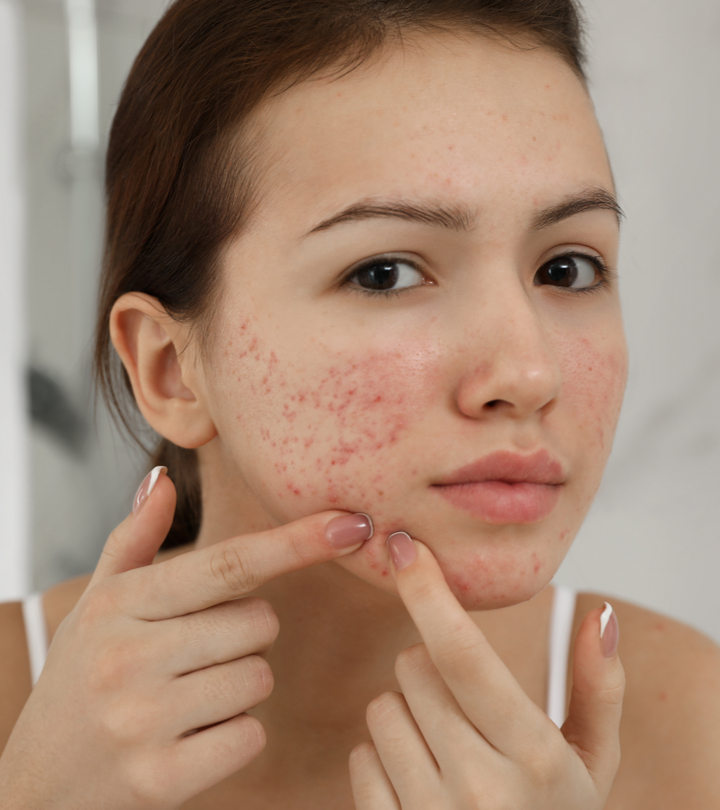The benefits of using vitamin D for acne have been debated for a long time now. However, this micronutrient (that can best be obtained through sunlight) is commonly used in acne and skin care products. What does science say? If vitamin D reduces acne flare-ups, what are its best food sources? In this article, we will explain whether vitamin D helps treat acne, how to use it, and some natural ways to improve the levels of this ‘sunshine vitamin’. Keep reading.
StyleCraze Trivia Vitamin D2 and D3 are the two prominent types of vitamin D. While the former is called ergocalciferol, the latter is known as cholecalciferol.
In This Article
Can A Lack Of Vitamin D Cause Pimples? – A Research-Backed Perspective
If you think vitamin D deficiency is not a global concern, think again. According to research, about 1 billion people worldwide have low vitamin D levels (1).
But, what is the link between vitamin D and acne? Can a vitamin D deficiency lead to acne breakouts? Here is what research tells us:
1. Vitamin D Regulates The Immune System
Shutterstock
Vitamin D plays an important role in the immune system, and its deficiency can lead to various skin diseases, including atopic dermatitis and psoriasis. As per a study conducted in South Korea, vitamin D deficiency is more common in people who have acne than in people who don’t (2).
Related: 8 Best Homeopathy Treatments For Psoriasis
2. Vitamin D Deficiency And Nodulocystic Acne
Another study conducted in Turkey concluded that there is a connection between low vitamin D levels and nodulocystic acne (3). It found that the subjects with acne had relatively lower vitamin D levels than the control group.
Related: Nodular Acne: Causes, Treatment Options, & Home Remedies
3. Vitamin D Taken Orally Can Help With Acne
Yet another study conducted in Egypt found that people with acne are more prone to vitamin D deficiency compared to healthy people (4). Hence, administering vitamin D can play a beneficial role in acne management with no reported side effects.
There is sufficient evidence to suggest that a lack of vitamin D can cause acne. In other words, using vitamin D appropriately and under expert guidance can keep acne breakouts at bay.
Moving on, let us look at the benefits of using vitamin D for acne.
Top 3 Benefits Of Using Vitamin D For Acne
1. Antimicrobial Properties
Shutterstock
Research suggests that vitamin D is power-packed with antimicrobial properties (5). Vitamin D boosts the body’s innate immunity by modulating the production of antimicrobial peptides. This plays a powerful role in managing atopic dermatitis, psoriasis, vitiligo, acne, and rosacea.
So if you have acne caused by bacteria, using vitamin D topically can help you manage acne and have a calming effect on your skin.
2. Anti-Inflammatory Properties
A recent study also claims that vitamin D induces an anti-inflammatory effect on acne due to its immune-regulatory function (6). So, taking an appropriate dose of vitamin D in the form of supplements can help tackle the inflammation issues that come along with acne, such as rash, redness, irritation, etc.
3. Antioxidant And Anti-Comedogenic Properties
Vitamin D has antioxidant and non-comedogenic properties (3). This means that it can scavenge the free radicals and unclog pores, which may help get rid of acne.
In the next section, let us look at how to use vitamin D for acne.
How To Use Vitamin D For Acne
Shutterstock
There are numerous ways to incorporate this vitamin into your daily living:
1. Consume Foods Rich In Vitamin D
A lot has been said about the potential link between diet and acne. Recent research suggests that high-glycemic load diets may exacerbate acne (7). So, keeping a food diary and noticing any patterns in your food intake and acne flare-ups can help you tackle acne.
That said, more research needs to be done to understand how certain foods can make acne worse and cause flare-ups.
As a precautionary measure, you can consume the following vitamin D-rich foods (8):
- Oily fish like salmon, sardines, herring, and mackerel
- Red meat
- Liver
- Egg yolks
- Cheese
- Mushrooms
- Fortified foods, including fat spreads, milk, fruit juice, and breakfast cereals)
If you are thinking of consuming dairy products such as milk and cheese, exercise caution as they can make the acne symptoms worse (7).
2. Take Dietary Supplements
You can also take supplements to take care of the daily required dosage of vitamin D. As per the UK’s National Health Service, children from the age of 1 year and adults need 10 mcg of vitamin D a day (8). This includes pregnant and breastfeeding women and people at risk of vitamin D deficiency. Additionally, babies up to the age of 1 year need 8.5 to 10 mcg of vitamin D a day.
It is best to speak to your dermatologist, who can prescribe the right dosage and frequency based on the severity of your acne, your skin type, dietary and lifestyle choices, etc.
Additionally, keep an eye out on the supplements you are taking, or else you might exceed the daily intake amount, leading to a vitamin D build-up in your system. Finally, remember to take vitamin D supplements along with your meal for the best results.
3. Apply Vitamin D3 Topically
Shutterstock
You can also apply vitamin D3 topically. Research suggests that topical application of vitamin D3 can safely help in treating a vitamin D deficiency (9).
4. Get Sun Exposure
Getting enough sunlight will not treat your acne, but it will raise your vitamin D levels. However, do not step out into the sun without wearing an SPF 30 (or higher) sunscreen. Otherwise, you run the risk of getting sunburn, premature signs of aging, and skin cancer.
Subscribe
Next, let us take a look at the side effects and risk factors to keep in mind when using vitamin D in any form.
Stylecraze Says Since researchers confirm that UV radiation boosts your vitamin D levels, you can use UV lamps to fight acne (10).
Side Effects And Risks To Keep In Mind
Shutterstock
One of the most important things to remember when consuming vitamin D in any form is that exceeding the daily intake can have serious side effects. So if you are not pregnant or breastfeeding, the daily limit of vitamin D intake has been set to 100 mcg per day (11).
The typical side effects of vitamin D toxicity include (12):
- Confusion
- Apathy
- Recurrent vomiting
- Abdominal pain
- Polyuria (urinating more than normal)
- Polydipsia (excessive thirst)
- Dehydration
- Hypercalcemia (above normal calcium level)
- Heart arrhythmia
- Tissue calcification
- Kidney stones
- Organ damage
- Bone pain
- Weakness
Finally, remember that your vitamin D levels can also decrease if you are on corticosteroid medication.
Related: Home Remedies For Kidney Stones – Here’s What Can Help
Infographic: Tips To Stay Safe Under The Sun
Vitamin D is a power-packed nutrient that plays a vital role in major bodily functions. Its antimicrobial and antioxidant properties may help in reducing acne. Getting enough sunlight can raise your vitamin D levels. However, you must keep a few tips in mind when you go out in the sun.
Check out the infographic below to know more!
Vitamin D plays an important part in maintaining the immune system. Therefore, vitamin D deficiency can cause several skin issues, especially acne. Vitamin D is a potent antioxidant and has antimicrobial, anti-inflammatory, and anti-comedogenic properties. So, using vitamin D for acne is one of the effective ways to manage them. Consuming vitamin D-rich foods, topical application, dietary supplements, or sun exposure may help solve the vitamin deficiency. However, you must be careful not to exceed the daily intake to avoid side effects. Consult a doctor before taking vitamin D supplements.

















